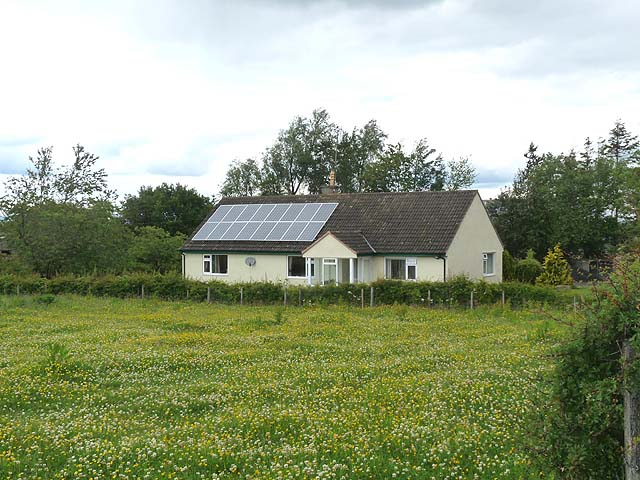
Solar panels or photovoltaic cells convert light into electricity. When several panels are joined in series it is called a module. When several modules are connected in series it is called an array.
Contrary to most people’s knowledge, generating electricity through solar panels does not require direct sunlight, which is good news for those living under Britain’s commonly cloudy sky. It also needs next to no maintaining, is completely silent, is more reliable than wind energy, lasts at least 20 to 30 years and any excess electricity generated can be sold back to the electricity supplier.
Types of Solar Cells
Choosing between the different types is mainly a matter of offsetting start up cost against the increased return the more expensive panels will bring in due to being more efficient. However there may be other factors to consider such as the shape of the roof and its ability to support more weight.
-

An example of a small monocrystalline cell. Amorphous Silicon has for many years been widely used to power calculators, however scientific advancement is steadily increasing their productivity. Whilst they currently cost about the same cost as the other types, they are still nowhere near as efficient. Their main advantage is their ability to be applied in thin layers to non-flat surfaces, making them suited to curved roofs or roofs that can not support much additional weight.
- Monocrystalline cells are the best photovoltaic cells on the market in terms of efficiency and durability. However this is also reflected in the price which makes them an uncommon choice in the UK.
- Polycrystalline cells are the most common choice due to being slightly cheaper to produce, however this slight reduction in price reduces efficiency by 20% compared to monocrystalline models.
- Thick Film Silicon is created by the constant depositing of polycrystalline onto a base material. Because the process is continuous as opposed to batch or mass production, the price is cheaper but the efficiency is also much lower.
- Photovoltaic Roof Tiles are a final and more expensive option. They have the advantage of being less obtrusive and visible than panels which is especially useful in conservation areas. If the roof is being re-tiled, replaced or converted than it reduces the expense of the tiles slightly as the are will not require normal tiles as well.

Positioning
Whilst any South, South East or South West facing position will work, a totally South facing surface is the fully optimized option. The vertical angle of the panels, cells and modules should be 30 to 40 degrees. This can be achieved using mounting brackets on flat roofs or roofs with sharper or lesser inclines. It is important for a structural engineer to check that the roof will be able to support the load. Marble Construction provide this free in the survey (also free).
Grants and Payback Period
The same Energy Savings Trust scheme as for solar water heating also gives out grants for solar panel installation. The Low Carbon Buildings Programme offers a generous grant of 50% off the cost of the installation and purchase up to £15,000. This does not include V.A.T which is at a reduced rate of 5%. The grant is also only available if the installation is carried out by an accredited professional service like Marble Construction and if the product used is also accredited.
Below are the calculated Payback Periods and estimated profits for selling back surplus electricity in an average house by freesolarpanelsuk.co.uk
-
The main reason for the high price of solar panels is cost of extracting and processing the polycrystalline silicon. System size: 1.08kWh. Annual export earnings: £28.45. Payback period: 9.59 years. Average yearly profit after payback: £299.23.
- System size: 2.16kWh. Annual export earnings: £56.91. Payback period: 9.45 years. Average yearly profit after payback: £604.03.
- System size: 2.88kWh. Annual export earnings: £75.88. Payback period: 10.09 years. Average yearly profit after payback: £772.18.
- System size: 3.96kWh. Annual export earnings: £104.34. Payback period: 9.45 years. Average yearly profit after payback: £1,107.40.
To find out the best option for your home, call Marble Construction on 0844 813 1111 or email sales@marbleconstruction.co.uk for a free survey.

